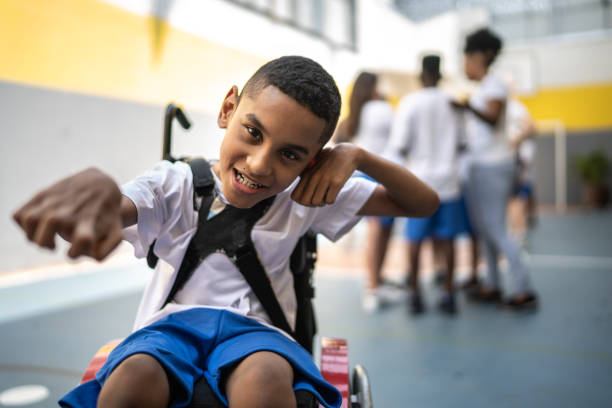Education and related services designed to meet the unique needs of students with disabilities. These include specially designed instruction, specialized equipment and materials and accessible settings.
Teachers are trained to educate kids with disabilities in the least restrictive environment, meaning they are taught alongside general education students whenever possible. There must be a clear justification for pulling your child out of mixed classrooms.
Continuum of Services
A child’s individualized education program, or IEP, determines the services he or she is eligible to receive. Kids who qualify are provided with specially designed instruction at no charge, and they may receive these services through a number of different settings, depending on their needs.
The IEP will include annual goals including short-term objectives, describing what the child is expected to accomplish and the steps required to achieve those goals. It will also describe the specific special education and related services to be provided to the child and how these will enable him or her to participate in regular educational programs. In addition, the IEP will include a statement of the least restrictive environment (LRE) in which the child is most likely to benefit from his or her special education program.
“Related services” are interventions that support the student in receiving special education, such as speech-language therapy, audiology and interpreting services, physical therapy, occupational therapy, counseling and/or psychological services, orientation and mobility services and/or transportation. Adapted physical education, which is a program of developmental activities, games and sports adapted to the interests, capacities, limitations or disabilities of students, is also considered a related service. Most states have separate funding mechanisms for high-cost related services. For example, some states have separate streams of money for teachers of the deaf and blind, music therapists and other specialists.
Special Classes
A child’s special education program includes specially designed instruction and related services. It is provided to children with disabilities ages 0-21 (some states have services set up for adults). Special classes adapt content, teaching methodologies and delivery of instruction to meet the student’s educational needs. Special education is at no cost to parents.
Teachers are trained to support the students in their classrooms. They can work with special education students in separate classrooms, alongside regular education students, or in integrated co-teaching settings. Some teachers earn a graduate degree in Special Education to gain additional qualifications and skills.
Depending on the student, CSE may recommend that a particular student receive specialized instruction in a special class. These classrooms provide a smaller student/teacher ratio, more individualized attention and instruction, and/or access to more specialized classroom resources.
These include services such as speech/language, psychological, occupational therapy, adaptive physical education, hearing impaired or visually impaired. These providers work with classroom teachers to share expertise and develop strategies for classroom instruction.
In general, the District’s goal is to serve kids in their neighborhood schools alongside their non-disabled peers. The philosophy is that kids with special needs perform better in mixed classes, and they benefit socially from interacting with their regular schoolmates. This is often referred to as the least restrictive environment. But sometimes a student’s needs can’t be met in the regular class, even with supplemental aids and services.
Learning Center
The goal of special education is to help kids with disabilities learn. But that doesn’t mean they have to be confined in their own classroom all day long. In fact, federal law requires that they be in general classrooms as much as possible, a practice known as least restrictive environment.
Some children require a more self-contained setting due to the severity of their disabilities. This is often the case with children who have severe sensory disabilities, such as deafness or blindness. Such children need intensive academic instruction, longer periods of study, and more repetition of materials in different forms.
Students in residential programs are typically provided with specialized academic programming that closely follows school curriculum and is tailored to the specific needs of each child. The program also allows students to take state and local exams, such as Regents and Common Core, in accordance with New York State and school district regulations.
Educational professionals can receive training and preparation in the field of special education through several schools, universities and organizations. In addition, each state has an agency responsible for overseeing special education in that state. The name of the agency varies from state to state, but is usually a department within the state’s education system. For example, the state of New York’s agency is called the Department of Education – Special Education.
Out of District Placements
We offer a range of out of district placement options to meet the needs of your child. These include, but are not limited to, separate classes, resource room programs and a self contained program.
Separate Class – This option is available for students who are best served in a smaller, more structured classroom environment with fewer peers. Instruction is based on the student’s IEP and delivered by a special education teacher. In addition to providing instruction, this classroom provides the opportunity for students to earn a Regents Diploma.
Resource Room – Students may be placed in a resource classroom to receive intensive assistance in a small group setting. The number of minutes spent in this classroom must be specified in the IEP.
a self-contained program – Students who require specialized instruction for more than half of the school day may be placed in a self-contained program. These programs must be located outside of the regular school building.
Private 853 Schools – Students who are not being educated to their full potential in a general education environment or in a local program of the Board of Cooperative Educational Services (BOCES) can be placed in an approved private academic school for the implementation of their IEPs. It is the responsibility of local education agencies (LEAs) that place children with disabilities in private academic schools to ensure that these placements provide the students with FAPE required by federal and state law.
